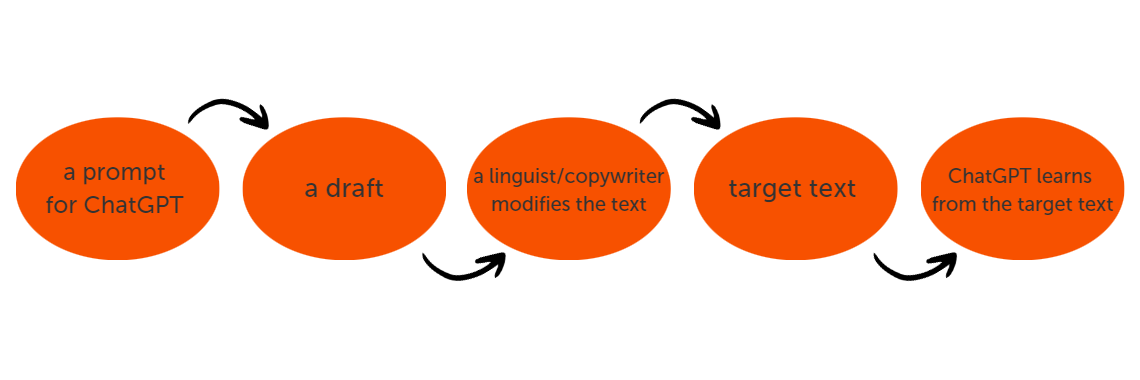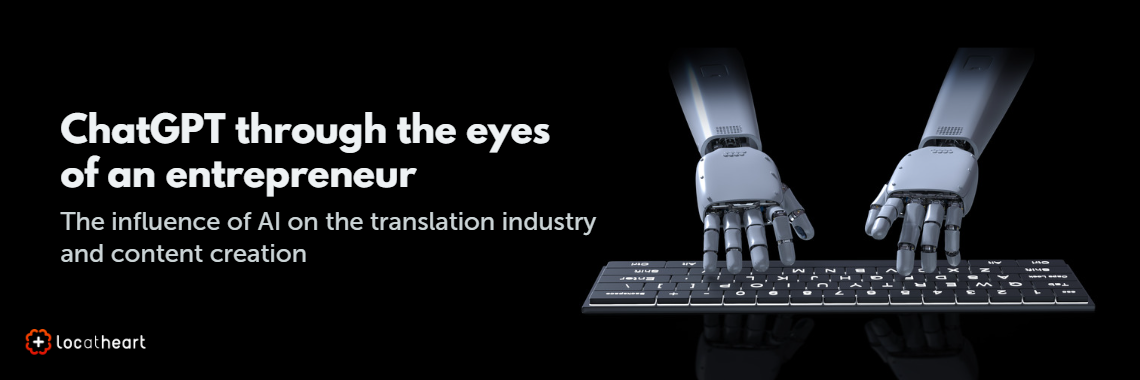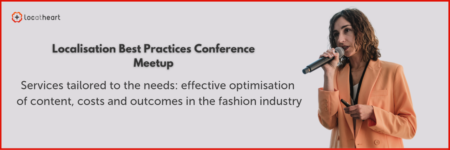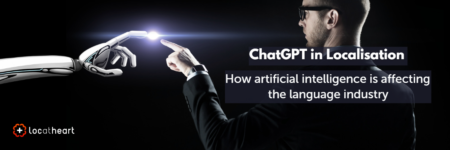ChatGPT through the eyes of an entrepreneur – the influence of AI on the translation industry and content creation
The commotion surrounding ChatGPT and artificial intelligence hasn’t died down yet – and probably won’t for a very long time. Supporters of the new technology perceive it as a chance to further human development, whereas opponents point to potential dangers and urge authorities to implement stricter regulations. While those of a somewhat more clear-headed approach stress that mature and autonomous artificial intelligence is still years and years away, it can’t be denied that we’ve been presented with an impressive tool whose potential has yet to be discovered. Be that as it may, we keep a watchful eye on the impact AI exerts on our everyday lives and wonder what real benefits – also business ones – it can offer.
Apparently, so do the participants of the “ChatGPT in Localization” conference – during one of several panel discussions, three veterans of the translation industry shared their thoughts and observations on the topic. They exchanged views on a revolution that’s happening right in front of our eyes, made predictions about the development of the language industry, and discussed their own experience related to AI’s role in enhancing localisation processes, creating texts and delivering content. The said renowned guests were: Olga Beregovaya (VP of AI and Machine Translation at Smartling), Diego Cresceri (founder and CEO of Creative Worlds) and Frederik R. Pedersen (co-founder and CEO of EasyTranslate).
Frederik R. Pedersen presented an original ChatGPT-based tool that automatically generates new pieces of content (e.g. blog posts, product descriptions, emails or advertisements appearing in marketing campaigns) with the use of “prompts” (commands) for artificial intelligence. AI allows for preparing hundreds of templates that can be then sent to copywriters and translators – thanks to this, linguists receive ready content on the basis of which they can create new texts. This in itself constitutes a significant change – instead of translating source texts, you can prepare guideline-compliant original content for particular languages or markets, and almost from scratch. As Pedersen noticed, in the future, using prompts can become a point of rivalry between language agencies. Each company using ChatGPT will have its own fiercely guarded repositories of instructions allowing for efficient utilisation of AI’s resources and models to generate specific content for particular markets.
Translation has always occupied a special place in the process of content creation. As Beregovaya remarked, however, even if it can’t be described as a mere addition, it is still of secondary importance. The use of AI lets you take over the entire process and make a translation agency a full-fledged partner responsible for all steps (end-to-end) towards successful delivery of linguistic materials, which includes:
We would face a shift of the function performed by language service providers, so accustomed to dealing with translation – a transformation of their business model and the way they price their services. As Beregovaya concluded, a partner for content creation doesn’t quote a per-word price.
For Diego Cresceri, on the other hand, technology is always an answer to some kind of a problem. In his experience, the predicament to be solved was a humongous demand for texts in English – a demand that far outstripped the supply of available native copywriters. ChatGPT has helped with adjusting the speed of text creation and, subsequently, with satisfying market needs. Artificial intelligence cannot be overestimated when it comes to time-consuming, edition-related tasks.
ChatGPT is great for creating new content, but its translation quality still leaves a lot to be desired and is inferior to the one displayed by dedicated machine translation tools. It serves best as an integral part of a bigger translation management system (TMS) – after all, it’s not a miraculous cure-all and definitely shouldn’t be treated as such. Olga Beregovaya drew attention to the fact that large language models (LLMs) are not only about ChatGPT; there are also other solutions, and the results will vary depending on the tested system (and the employed version of ChatGPT) and the task we assign it with. As Pedersen said, there is no single technology perfect in every aspect. What counts is how all available technologies are used to achieve a given goal.
A hypothetical work organisation chart could look like this:

One of ChatGPT’s strengths is that it can learn from text modifications introduced by humans; an editor’s or a copywriter’s intervention is necessary, however, as the model still makes subject-matter mistakes and sometimes provides “hallucinated” (i.e. erroneously generated, or made-up) information. But if we prepare adequate instructions that include data and keywords needed for SEO optimisation, artificial intelligence will be able to bulk-generate hundreds of text variants (e.g. product descriptions) in almost no time at all, vastly outstripping the limited production capacity of humans. This is why the best results can be obtained by combining the power of an AI language model with the power of human creativity.
ChatGPT won’t ever replace people, just as it won’t entirely replace CAT tools (i.e. tools for computer-assisted translation). On the contrary – the panel participants seem to lean towards the assumption that the solution will further spur the transformation of these tools, especially because what will be necessary for the process of creating new content will be constant access to context; in all likelihood, therefore, the old scheme of “source text column to the left, translation column to the right” will go out of date. According to Pedersen,
artificial intelligence might one day be able to make translations done by native speakers redundant, at least to some degree.
The expert wondered whether it would be better to generate texts directly in a desired language and then modify them, or to generate texts in a source language, translate them and then modify them. He also answered a question posed by an internet user – it was about how to ensure that the AI-generated texts are the same in each language. As Pedersen replied, the point is that they should not be the same.
Two main reservations concerning the new technology are about data privacy and potential plagiarism. Beregovaya remarked that when it comes to the former, worry returns every time we employ a freshly developed solution. She notices that the situation was similar when we started using machine translation tools. In that particular case, the problem was solved thanks to adequate service provision agreements between agencies and suppliers of the said technology – and this is why we can surely cope with the issue at hand as well. According to her, we should ask ourselves where we draw the line: whether we want to drive innovation and contribute to its progress or whether we prefer not to share our information. Pedersen, in turn, added that creating content from scratch is different from using a machine translation system, as the latter method doesn’t give us total control over what’s happening with sensitive data. As for texts’ originality, all participants agreed that they had never come across a situation where ChatGPT generated the same content twice. What they pondered over instead was the relation between texts produced by AI and the source materials used during its training. The same applies to visual arts, as there is the thorny issue of how to attribute works generated by AI – after all, the technology is provided a database to learn from.
To conclude, ChatGPT can be a useful tool for supporting content creation; it might also become a catalyst for the evolution of translation agencies that may become able to co-participate in the production process not only at the translation stage, but also in all the other phases. If that happens, they will become full-fledged partners for their clients, which will, in turn, change the business model in the language market. ChatGPT will help generate texts, deliver them in greater quantities and adjust them to different locales, which will take some burden off creators, especially when it comes to repetitive tasks. Human participation, however, will still be indispensable, not only in terms of instructing artificial intelligence, but also in terms of improving and verifying produced content.






Leave a Reply